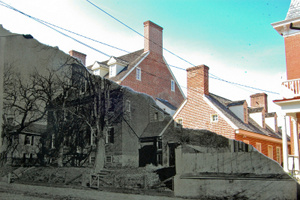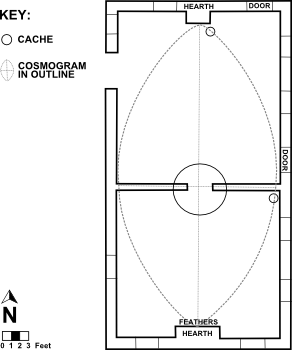THE JAMES BRICE HOUSE
Never Seen Anything Like It...

In the summer of 1998, under contract with the International Masonry Institute and with the assistance of the Maryland Historical Trust, Archaeology in Annapolis began excavations at the James Brice House. While excavating the east wing of the house, a wide but shallow concentration of artifacts was recovered beneath a doorway dividing two rooms. The artifacts had been deliberately been placed beneath the brick floor. They were unusual, and we did not know what they were.
What did the Artifacts Mean?
We discovered that African Americans had lived here throughout the 18th and 19th centuries. Similar excavations in Annapolis that had been conducted previously illustrated the survival of African-influenced spiritual practices well into the 19th century. By reading the autobiographies of former slaves written in the 1930s, we find that these artifacts are indicative of a series of African American folk beliefs, called Hoodoo. Hoodoo was widely practiced throughout the 19th century.
What do we Know About Hoodoo?

Hoodoo represents beliefs about spirits that could be found in sacred places and used to cure diseases, create luck, and foretell the future. Seen as a means of taking control of everyday life, Hoodoo plays off of the idea that everyday objects can be used to manage spirits. Common examples of Hoodoo materials include bottles buried beneath doorways to keep out witches, pierced coins worn on the body to bring luck, and red flannel sacks (often called mojo bags) filled with a variety of materials, used to either bring luck or cause harm.
Going Down to the Crossroads
The Brice House hoodoo cache was found in an oval pattern to the south side of the doorway and just to the north side of the same door. Caches were also adjacent to each fireplace in both the north and south rooms. The room had a north-south passage and an east-west dividing wall, thus creating a cross pattern, or x. The artifacts were placed at the focal point of the cross-the doorway itself.
19- and 20th-century folklore accounts of Hoodoo practices, as well as lyrics found in numerous blues songs, make reference to the power of the crossroads. The Hoodoo artifacts make a crossroads that was intended to give its makers active control over their own lives-including such applications as curing rheumatism, protecting children, assisting with finding a mate, and warding off a harsh mistress or master.
Further Reading
Cochran, Matthew David
1999 Hoodoo’s Fire: Interpreting Nineteenth Century African-American Material Culture at the Brice
House, Annapolis, Maryland. Maryland Archaeology 35(1):25-33.
Harmon, James and Jessica Neuwirth
2000 Archaeological Investigations at the James Brice House (18Ap38): A National Historic Landmark
Site. Annapolis, Maryland. Report prepared for the Historic Annapolis Foundation.
Leone, Mark and Gladys-Marie Fry
1999 Conjuring in the Big House Kitchen: An Interpretation of African American Belief Systems, Based
on the Use of Archaeology and Folklore Sources. Journal of American Folklore. 112:445:372-403



